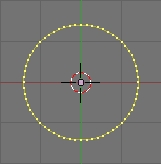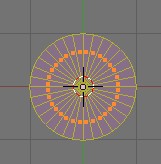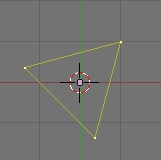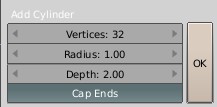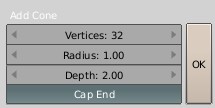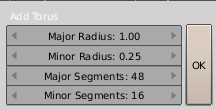Manual/Mesh Primitives
From BlenderWiki
Contents[hide] |
Basic Mesh Objects
Description
A common object type used in a 3D scene is a Mesh. Blender comes with a number of 'primitive' mesh shapes that you can start modelling from.
Options
Basic Objects shows the variety of basic Mesh objects that can be created.
Plane
A standard plane contains four vertices, four edges, and one face. It is like a piece of paper lying on a table; it is not a real three-dimensional object because it is flat and has no thickness. Objects that can be created with planes include floors, tabletops, or mirrors.
| Note: You can make the mesh three-dimensional by moving one of more of the vertices out of the plane of the plane. |
Cube
A standard cube contains eight vertices, 12 edges, and six faces, and is a real three-dimensional object. Objects that can be created out of cubes include dice, boxes, or crates.
Circle
A standard circle is comprised of n vertices. The number of vertices and radius can be specified in the popup window which appears when the circle is created, shown in 'Add circle popup window'. When 'Fill' button is active, the circle will be filled with triangular faces which share a vertex in the middle. However the circle is only a flat shape. If it is not filled and you want to render it, you must assign it a wireframe material (Shading (F5) context, Material buttons sub-context, Links and Pipeline panel and finally the Wire button).
The more vertices the circle contains, the smoother its contour will be (see 'Circle' and 'Triangle').
| Note: You can make the mesh three-dimensional by moving one or more of the vertices out of the plane of the circle. |
Examples of circle objects are disks,plates, or any kind of flat and round object.
UVSphere
A standard UVsphere is made out of n segments and m rings. The level of detail and radius can be specified in the popup window which appears when the UVsphere is created. Increasing the number of segments and rings makes the surface of the UVsphere smoother. Segments are like Earth's meridians, going pole to pole and rings are like Earth's parallels. Example objects that can be created out of UVspheres are balls, heads or pearls for a necklace.
| Note: If you specify a six segment, six ring UVsphere you'll get something which, in top view, is a hexagon (six segments), with five rings plus two points at the poles. Thus, one ring fewer than expected, or two more, if you count the poles as rings of radius 0. |
Icosphere
An Icosphere is made up of triangles. The number of subdivisions and radius can be specified in the window that pops up when the Icosphere is created; increasing the number of subdivisions makes the surface of the Icosphere smoother. At level 1 the Icosphere is an icosahedron, a solid with 20 equilateral triangular faces. Any increasing level of subdivision splits each triangular face into four triangles, resulting in a more spherical appearance. Icospheres are normally used to achieve a more isotropical and economical layout of vertices than a UVsphere.
| Note: There is possible to add an icosphere subdivided 500 times. Adding such dense mesh is a sure way to program crash. An icosphere subdivided 10 times would have 5,242,880 triangles, so be very careful about this! |
Cylinder
A standard cylinder is made out of n vertices. The number of vertices in the circular cross-section can be specified in the popup window that appears when the object is created; the higher the number of vertices, the smoother the circular cross-section becomes. The radius and depht parameters controls dimensions of cylinder. Objects that can be created out of cylinders include handles or rods.
If 'Cap Ends' is inactive, the created object will be a tube. Objects that can be created out of tubes include pipes or drinking glasses. (The basic difference between a cylinder and a tube is that the former has closed ends.)
Cone
A standard cone is made out of n vertices. The number of vertices in the circular base, dimensions and option to close the base of cone can be specified in the popup window that appears when the object is created; the higher the number of vertices, the smoother the circular base becomes. Objects that can be created out of cones include spikes or pointed hats.
Torus
A doughnut-shaped primitive created by rotating a circle around an axis. The overal dimensions are defined by the major and minor radius. The number of vertices can be different for the circles and is specified in the popup window with both radii.
Grid
A standard grid is made out of n by m vertices. The resolution of the x-axis and y-axis can be specified in the popup window which appears when the object is created; the higher the resolution, the more vertices are created. Example objects that can be created out of grids include landscapes (with the proportional editing tool) and other organic surfaces. You can also obtain a grid when you create a plane then use a sudivide modifier in Edit mode.
Monkey
This is a gift from old NaN to the community and is seen as a programmer's joke or "Easter Egg". It creates a monkey's head once you press the Monkey button. The Monkey's name is Suzanne and is Blender's mascot.
|

